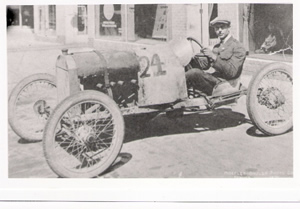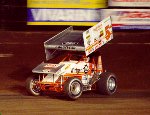
Noel Bullock in 1922 (Click to see larger image)
Don is a former racer and author of a number of books on the Roadster and Sprint Car era. See the end of this article for information on three of them.
Sprint car racing really had its beginning in the years following World War 1. The racing before then was mostly with larger cars that were primarily modified stock cars. Most of this racing was in the larger cities with factory sponsored race teams. After the war racing came to the rural areas with competition on the country fair horse tracks and machines built from stripped Model T Fords. There were other makes of cars but the Model Ts were plentiful, cheap and there were soon lots of speed parts available. These home built machines were not called sprint cars—they were simply "race cars" or maybe "dirt track cars"
By the 1930s and 1940s the Model T based cars evolved into more refined racers. There were still lots of Ford parts with the four cylinder Model A-B engine being the base for many racing conversions. Special racing engines such as the Millers and Offenhausers were available for those who could afford the price tag. Much of the racing was still on the country and state fair horse tracks but purpose built auto racing tracks were starting to emerge. These cars were still not called sprint cars. In the 1930s the midgets had come on the racing scene so the bigger machines were called "big cars"
The 1950s and 1960s brought about improvements in the design of cars and professionally built race cars became more common. In the 1950s many cars still used the pre World War 2 four cylinder engines but the flathead V8 Ford or Mercury engines were also popular. In the 1960s the Chevy V8 came into its own and soon made other engines obsolete. There was still a bit of racing on the horse tracks but this was on the way out In around 1950 somebody thought of the name "sprint car" so finally we had sprint car racing
Beyond the 1960s the cars slowly evolved into what they are today. Safety dictated the use of the cage roll bar. Engines developed more horsepower requiring wider tires and body designs and wings took advantage of aerodynamic down forces.

Click Here for a copy of the flyer on Don's booklet Tin Lizzies.
<& /components/License.mhtml, license=>'CC-NC-SA', author=>'Don Radbruch', owner=>'Don Radbruch', date=>'2006' &> <& /components/GenericFooter.mhtml &>